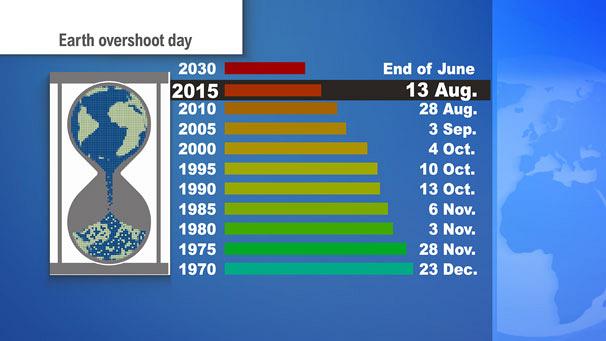Guess What? We Have Already Used Up All Of Earth's Resources For 2016
Language
Reading Level
Listen to Article

Monday, August 8, was Earth Overshoot Day. Calculated annually by the environmental advocacy group, Global Footprint Network (GFN), it is the day when humanity has consumed all the natural resources — produce, meat, fish, water, and wood — that our planet can regenerate in a single year. This means that for the rest of 2016, we will be using natural resources that are impossible to replace.
For those that are a little confused, it is akin to spending your entire year’s allowance by August and then borrowing money from friends, knowing fully well that you cannot repay the loan. GFN says that the same thing happens in the case of the Earth, “because we emit more carbon dioxide into the atmosphere than our oceans and forests can absorb, and we deplete fisheries and harvest forests more quickly than they can reproduce and regrow.” The date of Earth Overshoot Day, which varies each year, is calculated using the following formula:
(Planet’s Biocapacity / Humanity’s Ecological Footprint) x 365 = Earth Overshoot Day

While that may appear a little complicated, think of it as a bank statement that compares income against expenses. The “income” in this case is the Planet’s Biocapacity. Calculated using data from the United Nations, it accounts for our planet’s annual production capacity. The “expense” is Humanity’s Ecological Footprint — the natural resources we collectively use every single day of the year.
In an ideal, fully sustainable world, we should only spend what we have. This means that Earth Overshoot Day would fall on December 31, or perhaps even spill into the following year, indicating that we are saving some resources for a rainy day. That did happen in 1961, when we only utilized three-quarters of what the planet produced. In 1970, we almost made it through the year, with Earth Overshoot Day falling on December 23.

Unfortunately, the day has been creeping up rapidly since 2014 when it fell on August 19. In 2015, it was August 13, and this year, the earliest thus far — August 8! This means that the combination of overfishing, cutting down forests and emitting high volumes of carbon dioxide is depleting our natural resources to dangerously low levels. The only way to sustain this demand would be to have 1.6 earths, which as we all know, is not possible.
So who are the worst offenders? According to GFN’s calculations, Australia tops the list, with the United States coming in a close second. If the world’s population started to live like either of these countries, we would need 5.4 or 4.8 earths respectively, to keep up with the demand! While the citizens of the world’s most populous country, China, are also using resources beyond what a single planet can provide, they are surprisingly low on the list of resource-hogging culprits.

Fortunately, experts say that the situation is not as grim as it sounds. Many countries are already taking steps to reduce carbon emissions, which accounts for 60% of our ecological footprint, by switching to solar or wind-generated power. Earlier this year, Costa Rica survived on electricity from renewable sources for 75 consecutive days! Germany, Portugal, and Britain are also rapidly moving in the same direction. Ratification of the Paris Climate Change Agreement, which includes a total of 197 countries representing 98 percent of the world’s greenhouse gas emissions, will also go a long way in reducing the burden on our planet.
Individuals can also help by eating less meat, walking, biking, or taking public transportation, as well as adopting the three R’s: Reduce, Reuse, & Recycle. If we all work together, we can help push back Earth Overshoot Day to December 31, or even beyond!
Resources: natureworldnews,qz.com,www.overshootday.org
Cite Article
Learn Keywords in this Article
382 Comments
- THATBOIabout 7 yearsWOW
- h/hover 7 yearscool
- Salwa musabehover 7 yearsCan u add more info about natural resources pls
- christacalmost 8 yearsNoOOooooOooOOo! WE ARE DOOMEDDDDDD!
- crazyronialmost 8 yearsllamas shall take over THEY SHALL TAKE OVER I SAY RAH
- rainbownation23almost 8 yearsI love the amazing things that happen to the world.
- bobalmost 8 yearsi really like this website
- Demonalmost 8 yearsyeah India... but I live in Canada :)
- bobalmost 8 yearsthis is very helpful
- bunny22almost 8 yearshi peeps wut in the world haha




